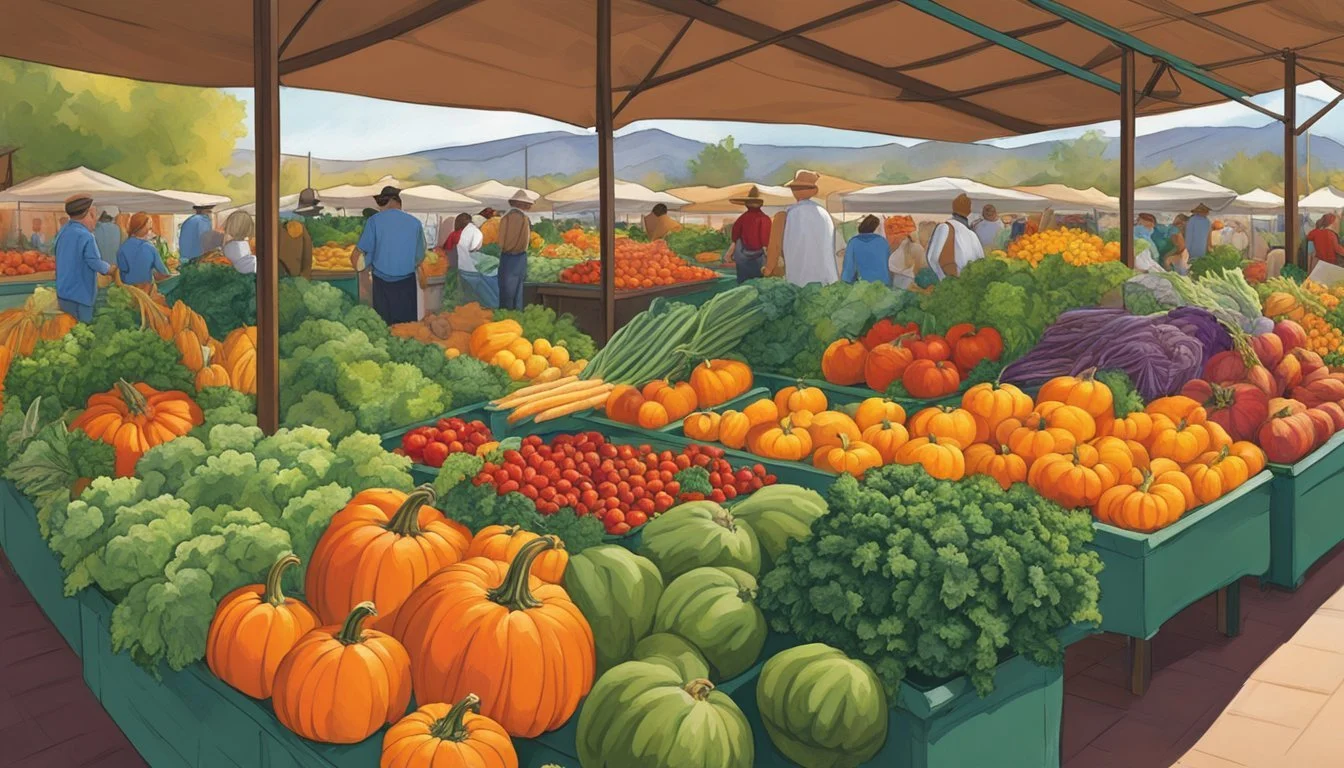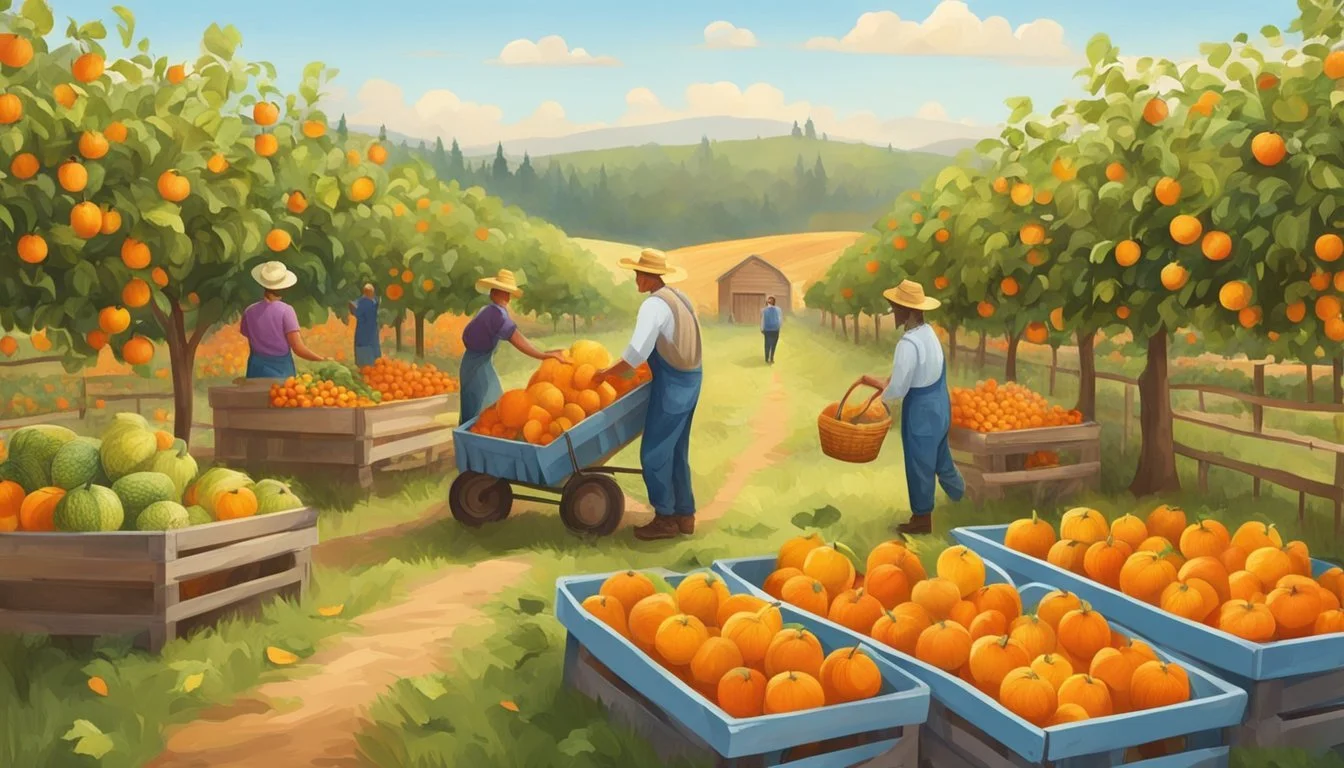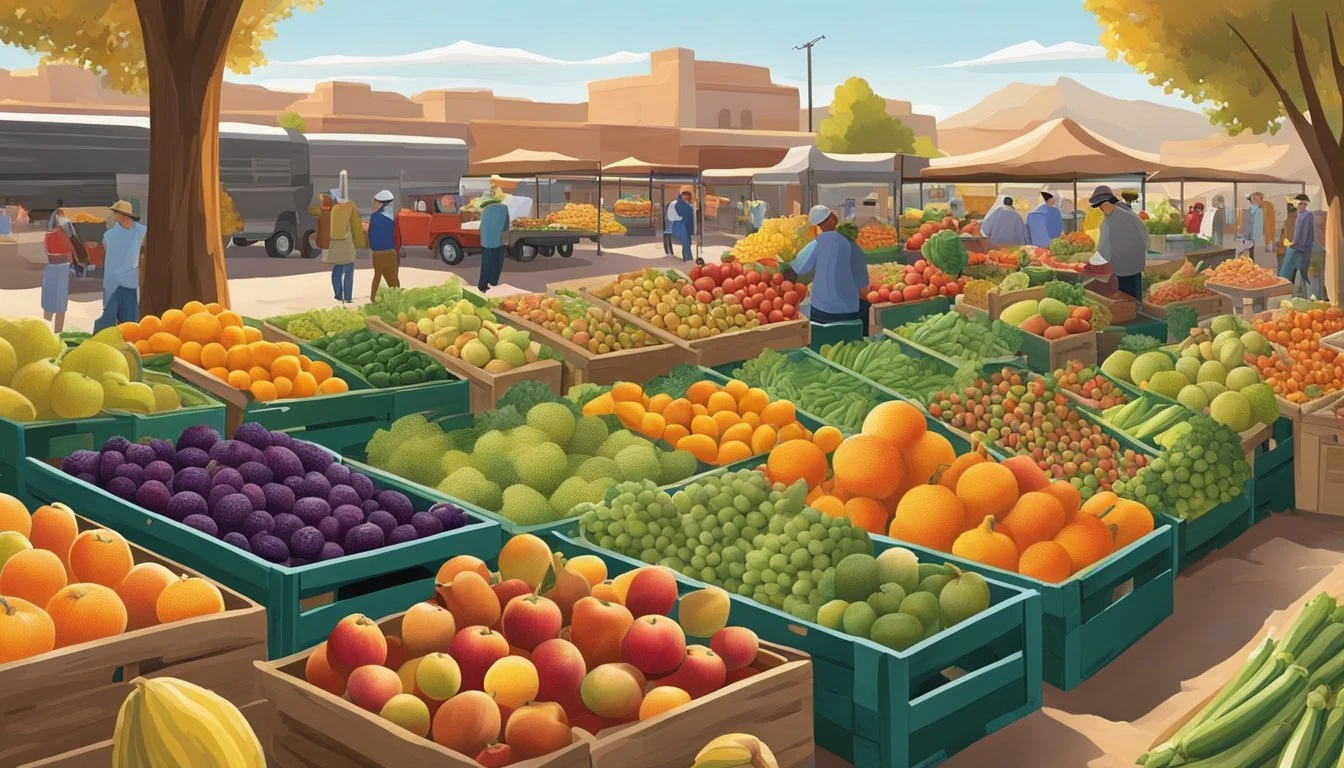Arizona Seasonal Fruit & Vegetables in November
Your Guide to Fresh Produce
This Article is Part of our Arizona Seasonal Fruit & Veg Calendar
In November, Arizona's unique climate fosters the growth of a variety of seasonal fruits and vegetables, offering a bounty that is both diverse and abundant. As fall progresses, the state's agricultural output transitions, making it an ideal time for residents and visitors to explore a rich harvest. The mild temperatures of this desert state allow for an extended growing season, which is particularly beneficial for a wide assortment of produce.
Within the Arizona region during November, gardens and farms yield a plethora of produce, including root vegetables and hearty greens. Beets (how long do beets last?), with their earthy flavor and vibrant colors, are harvested, along with crisp, leafy greens such as arugula and spinach that thrive in the cooler temperatures. They join the ranks of bok choy and broccoli (how long does broccoli last?), which also reach their peak during this time. Fruits may be less abundant in the late fall, but citrus varieties begin to make their appearance, hinting at the abundant winter harvest to come.
Local farmers' markets and grocery stores become showcases for these fresh, seasonal offerings, encouraging a connection between consumers and the land. Engaging with Arizona's seasonal produce not only supports the local agricultural community but also ensures that individuals are getting some of the freshest and most flavorful produce available. A focus on vegetables like radishes, carrots, and greens aligns with the healthy, vibrant lifestyle promoted by Arizona's culinary culture.
Understanding Seasonality
In the state of Arizona, the concept of seasonality is paramount for appreciating the diverse produce harvested throughout the year. As fall transitions into winter, the seasonal shift brings forth a bounty of fresh fruits and vegetables that are at their peak in November. This period is marked by a distinct selection, reflecting the local climate and growing conditions.
Fall ushering into winter in Arizona sees a range in temperature that allows for an assortment of produce to thrive. Consumers benefit from the robust flavors and nutritional value of fruits and vegetables sourced in their prime. Here is a concise guide to what is typically in season during this month:
Vegetables Fruits Beets Broccoli Brussels sprouts (how long do brussels sprouts last?) Cabbage Cauliflower Celery Kale
This selection embodies the essence of seasonal eating, where one enjoys produce that is harvested at the time nature intended. By consuming seasonal and local products, individuals not only savor the freshest flavors but also support sustainable agricultural practices within the state.
Arizona's unique climate requires an understanding of what grows when. This knowledge is essential for chefs, home cooks, and consumers aiming to make the most of their ingredients. Introducing these seasonal ingredients into one's diet can also be a delightful exploration of the state's agricultural diversity.
Seasonal Fruits in Arizona
Arizona offers a vibrant selection of ripe fruits in November, with a focus on citrus and tree fruits which are peaking in freshness and flavor during this time.
Citrus
November marks the beginning of citrus season in Arizona, with a variety of fruits becoming ready for harvest.
Oranges: They are particularly fresh and juicy in November.
Lemons: Available and ideal for adding a splash of citrus to dishes and drinks.
Grapefruit: The fruit is at its sweetest and can be enjoyed in a multitude of ways.
Tangerines: Easy to peel and perfect for a quick, healthy snack, tangerines are a November favorite.
Tree Fruits
While citrus fruits are a highlight, other tree fruits also share the spotlight in November.
Apples: Varieties such as Fuji and Gala reach their peak in terms of sweetness and crunch.
Pears: Often overlooked, pears this time of year provide a soft, buttery texture and are versatile for use in both cooking and baking.
Pomegranates: The deep red seeds deliver a burst of tart flavor and are rich in antioxidants.
Persimmons: These are less common but make a delightful treat with their honey-like flavor.
These fruits encompass the seasonal best of what Arizona has to offer in November, each boasting freshness and local flavor that supermarket imports often lack.
Seasonal Vegetables in Arizona
During November in Arizona, a diverse array of vegetables reaches peak maturity, offering fresh and flavorful options for seasonal cooking.
Root Vegetables
Arizona's November soil yields a variety of root vegetables. These include:
Beets: Deeply pigmented and earthy-flavored, beets are a nutritious choice.
Carrots: Known for their crunchy texture and sweetness.
Radishes: Offering a crisp bite and a peppery kick.
Sweet Potatoes (What wine goes well with sweet potatoes?): Loaded with vitamins and a natural sweetness.
Turnips: These can be eaten raw or cooked, presenting a slightly bitter taste.
Leafy Greens
The cooler November weather is conducive to the growth of leafy greens, among them:
Spinach: Tender leaves that work well both raw and cooked.
Arugula: It has a distinctive, peppery flavor.
Kale: A robust green, high in nutrients.
Chard: Known for its bright-colored stems and deep green leaves.
Winter Squashes
Several types of winter squashes are harvested in November, each with its own unique qualities:
Butternut Squash: (how long does butternut squash last?) With its creamy texture and sweet, nutty flavor, it's versatile in the kitchen.
Acorn Squash: Smaller in size, it's perfect for baking and stuffing.
Spaghetti Squash: When cooked, the flesh pulls apart in strands resembling spaghetti, providing a low-carb alternative to pasta.
Herbs and Other Plant Foods
In the mild November climate of Arizona, gardeners have the opportunity to grow and harvest a variety of herbs and plant foods that thrive in cooler temperatures. This is a prime time for herbs such as basil, cilantro, and mint, which can be used to enhance the flavors of numerous dishes.
Basil is favored for its aromatic leaves, commonly used in Italian and Southeast Asian cooking. It flourishes in the state's fall climate and can be harvested until the first frost if well-maintained.
Cilantro, known for its bold, citrus-like flavor, is a staple in Mexican and South Asian cuisine. It grows quickly in the cooler November weather, although it requires regular watering to keep the soil moist for optimal growth.
Mint offers a refreshing, cool taste and is versatile in its use, from teas to garnishes in various recipes. It prospers during Arizona's autumn, though it's advisable to contain its growth as it can spread rapidly.
In addition to these herbs, November is also favourable for other plant foods that complement Arizona's seasonal palette:
Plant Foods Harvest Times Bok Choy October through March Broccoli October through March Brussels Sprouts December through March Cabbage January through April
Gardeners seeking a robust flavor profile in their culinary creations find that incorporating these herbs and plant foods into their November gardens not only maximizes the seasonal growth cycle but also enriches their home cooking with fresh, home-grown ingredients.
Harvesting and Storing Tips
When harvesting sweet potatoes in Arizona, gardeners should wait until the foliage starts to yellow, indicating maturity. They must carefully dig around the plants to avoid damaging the tubers. After harvest, sweet potatoes require curing in a warm, humid place for about 10 days to toughen their skin for storage.
For onions, they should be harvested when their tops begin to fall over and yellow. One should allow them to dry in a warm, airy location for several weeks. Once the outer layers are crispy, trim off the roots and cut the tops down to about an inch before storing.
Potatoes, on the other hand, are ready when the tops die back. They should be dug up and allowed to dry on the soil surface for a few hours. For storing potatoes, it's imperative to keep them in a cool, dark, and humid environment to prevent sprouting.
Here's a quick reference table for storage:
Vegetable Ideal Temperatures for Storage Relative Humidity Duration Sweet Potatoes 55-60°F (13-16°C) 85-90% Up to 6 months Onions 32-40°F (0-4°C) 65-70% Up to 12 months Potatoes 35-40°F (2-4°C) 80-90% 5-10 months
Key to successful storage is minimizing light exposure to prevent greening and ensuring good ventilation to fend off rot. It's recommended to check stored produce regularly and remove any that show signs of spoilage to protect the rest of the harvest.
Arizona's Farming Regions
In the state of Arizona, farming regions are distinguished by their unique climates and geographies, contributing to the diversity of produce harvested throughout the year. November marks a transitional period for the regions within this southwestern state.
Central Arizona, including the Phoenix metropolitan area, possesses a warm climate conducive to a variety of crops. During November, this region's farms are actively harvesting winter vegetables, benefiting from the mild temperatures that avoid the extremes of the summer heat and winter frosts.
In contrast, Northern Arizona faces a cooler climate, especially as winter approaches. The colder temperatures can limit the growing season for some crops, but hardier vegetables continue to thrive. Farmers in this area often use the colder months to prepare for the spring growing season.
The farming regions are further categorized by their regional differences:
Yuma: Known as the winter lettuce capital, this region's warm winters make it one of the prime areas for growing leafy greens during cooler months, with harvest perfect timing for November demands.
Southeastern Arizona: This area supports a diverse range of produce, including orchard fruits, due to its slightly higher elevation and cooler temperatures compared to the Phoenix area.
Arizona's farming is integral to the state's economy, with November serving as a showcase month for Arizona's commitment to providing fresh produce. Each farming region adapts to its climate, ensuring a steady supply of fruits and vegetables.
Local Markets and Availability
In Arizona, November marks a time when local markets abound with a variety of seasonal produce. These farmers' markets become hubs for community gatherings and offer a clear glimpse into Arizona's agrarian output during the fall season.
Farmers' markets across the state showcase a bounty of November harvests. Root vegetables, like beets and carrots, stand out for their freshness and earthy flavors. (What wine goes well with earthy flavors?) Greens such as lettuce, spinach, and the hardier kale varieties are readily available, as are the versatile winter squashes. Arizona's climate allows for an extended season for some summer crops; thus, markets might still carry items like eggplants and peppers.
Seasonal Availability Produce Item Early November - Sweet Potatoes - Pumpkins Mid to Late November - Citrus Fruits - Pomegranates
Local producers take pride in their array of citrus fruits, which start to peak in November. Oranges, lemons, and grapefruits begin to take center stage, adding a vibrant color and zest to the markets. Pomegranates, another seasonal favorite, are celebrated for their jewel-like seeds and antioxidant properties.
Availability is not just limited to fresh produce. Many markets also offer a selection of locally produced honey, artisan breads, handcrafted cheeses, and preserves, illustrating the rich variety of Arizona's local food scene.
Shoppers can find these seasonal items with ease, as Arizona promotes clear labeling of locally sourced produce. Consumers gain a deeper connection to their food, learning about the journey from farm to table. The availability of fresh, local, and seasonal items not only supports Arizona's economy but also encourages sustainable eating practices.
Seasonal Recipes and Preparation
In Arizona, the splendor of November is marked not just by the cooling weather but also by the array of seasonal produce that arrives, perfect for creating warm, comforting dishes. The following selection of fruits and vegetables are prime for cooking in November: broccoli, Brussels sprouts, cabbage, beets, and a sweet variety of fruits like pomegranates and persimmons.
For the vegetable bounty, one might roast Brussels sprouts with a drizzle of olive oil and a sprinkle of sea salt (how long does sea salt last?) to bring out their natural flavors. Alternatively, they may consider a vibrant beet salad tossed with orange segments and a balsamic vinaigrette.
Broccoli, at its peak freshness during this time, can be transformed through steaming and served with a hint of lemon zest (how long does lemon zest last?) or incorporated into a creamy soup to warm the palate on cool November evenings. Cabbage offers versatility, easily enjoyed in a hearty stew or fermented to make sauerkraut, boasting both flavor and probiotic benefits.
Fruit/Vegetable Recipe Idea Preparation Method Broccoli Creamy Broccoli Soup Steam and blend with stock and cream Brussels sprouts Roasted Brussels Sprouts Roast with olive oil and salt Beets Beet and Orange Salad Roast and toss with vinaigrette Cabbage Sauerkraut Ferment with salt
When one turns to fruits, they can enjoy the sweetness of the season by preparing persimmons into a jam or incorporating the bright seeds of pomegranates into a fresh salad adding a burst of color and a tangy flavor. Each of these preparations showcases the produce in a manner that is simple, allowing their natural flavors to shine through.







